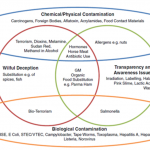Food industry professionals know how supply chain transparency plays a major role in keeping everything running smoothly. Brand representatives want confirmation that their agricultural partners can fill upcoming orders. If things go wrong and people get sick from what they eat, better visibility is vital in addressing and curbing such issues.
Artificial intelligence (AI) is a critical part of better food supply chain awareness among all applicable parties. This article briefly discusses some interesting examples.
Applying AI to Crop Management
Even the most experienced agricultural professionals know farming is far from an exact science. Everything from pests to droughts can negatively impact a growing season, even if a farmer does anything they can to influence production in their favor.
However, AI can help predict yields, enabling farmers to maintain transparency and set accurate expectations for parties further down the supply chain. That’s especially important in the increasingly popular farm-to-table movement, which shortens how far produce travels and may entail using it on the same day someone picks it.
One newly developed machine-learning tool relies on computer vision and ultra-scale images taken from the air to categorize lettuce crops. More specifically, it captures details about the size, quality, and quantity of the heads. Combining that with GPS allows more efficient harvesting.
Tracing Foodborne Illness
CDC Statistics indicate foodborne illnesses sicken one in six people every year in the United States. FSMA contains rules and actions for food processing facilities to prevent such instances, but outbreaks still happen. AI could be yet another useful mitigation measure.
Researchers at the University of Georgia determined that, since the 1960s, approximately a quarter of Salmonella outbreaks have been from the Typhimurium variation. They trained a machine-learning algorithm on more than 1,300 Typhimurium genomes with known origins. The model eventually achieved 83% accuracy in predicting certain animal sources that would have the Typhimurium genome. It showed the most accuracy with poultry and swine.
Reducing Food Waste
Waste is a tremendous problem for the food supply chain. In the United States, data shows that upwards of 40% of packaged consumables get discarded once they reach the use-by date. That happens whether or not the products are actually unsafe to eat.
However, better visibility into this issue has a positive impact on food distribution. For example, some restaurants give people discounted meals rather than throwing them away. In other cases, grocery stores partner with charities, helping people in need have enough to eat.
Scientists in Singapore have also created an electronic “nose” that uses AI to sniff out meat freshness. More specifically, it reacts to the gases produced during decay. When the team tested the system on chicken, fish and beef, it showed 98.5% accuracy in its task. Using AI in this manner could bring transparency that cuts food waste while assuring someone that a food product is still safe to eat despite the appearance of it being expired based on Best Before’ labeling.
Removing Guesswork From Dynamic Processes
People are particularly interested in how AI often detects signs that humans miss. Thus, it can often solve problems that previously proved challenging. For example, even the most conscientious farmers can’t watch all their animals every moment of the day and night, but AI could provide greater visibility. That’s valuable since animal health can directly impact the success of entire farming operations.
One European Union-funded AI project took into account how animal health is a primary factor in milk production. The tool compared cows’ behaviors to baseline levels and characteristics of the animals at the most successful farms. It then provided users with practical insights for improvement. Europe has at least 274 million dairy cows, and their milk makes up 11%-14% of Europeans’ dietary fat requirements. Those statistics show why keeping herds producing as expected is critical.
AI is also increasingly used in aquaculture. Until recently, fish farming professionals largely used intuition and experience to determine feeding amounts. However, that can lead to waste. One company uses artificial intelligence to sense fish and shrimp hunger levels and sends that information to smart dispensers that release food. The manufacturers say this approach causes up to a 21% reduction in feed costs. Other solutions track how much fish eat over time, helping farmers adjust their care protocols.
Fascinating Advancements in Supply Chain Transparency
These instances are only a sampling of what AI can do to support the food supply chain. Although most of them are most relevant to producers, consumers will likely reap the benefits, too. For example, some food labels already show the precise field associated with the potatoes used for a bag of chips. Once technology reaches a point where most consumers could have advanced AI apps on their phones, it could be a matter of aiming a smartphone’s camera at any food product and instantly seeing the path it took before reaching the consumer. It’s too early to know when that might happen. Nevertheless, what’s already possible with innovative technology is compelling in its own right and makes people rightfully eager to see what’s on the horizon.








